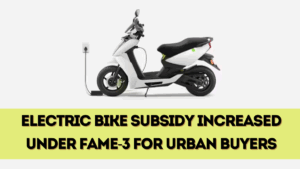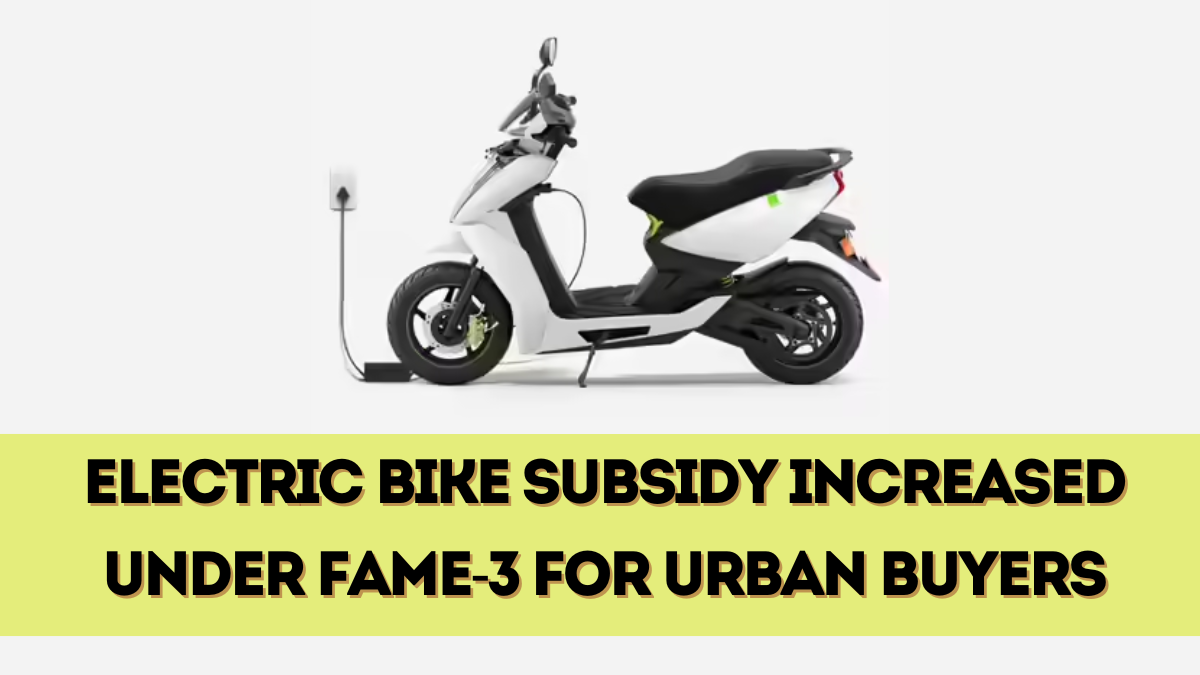India’s electric mobility journey reached a new milestone in 2025 with the revision of subsidies for electric two-wheelers under the FAME-3 scheme. The government has increased financial support for e-bike buyers, particularly in urban areas where demand is rising rapidly.
The updated electric bike subsidy 2025 aims to make green mobility more affordable and accessible to millions of daily commuters.

Why the Subsidy Update Was Needed
Electric two-wheelers have been at the center of India’s EV revolution. They are cheaper than cars, easier to charge, and perfect for city travel.
However, high upfront costs and limited charging infrastructure slowed adoption. Many buyers hesitated to switch from petrol bikes despite rising fuel prices.
The revised subsidy directly addresses this issue by lowering purchase costs and encouraging a larger shift to electric mobility.
Key Features of the FAME-3 Subsidy in 2025
The new FAME-3 policy brings significant benefits for urban buyers.
-
Higher Subsidy Amount: Buyers now get up to ₹15,000 per kWh of battery capacity, capped at 30% of the e-bike’s cost.
-
Urban Focus: The scheme prioritizes metro and Tier-1 cities where air pollution and traffic congestion are highest.
-
Broader Eligibility: More models now qualify, including entry-level e-bikes and scooters.
-
Direct Benefit Transfer: Subsidies are applied at the point of purchase, reducing the final price instantly.
This makes electric two-wheelers significantly cheaper and more attractive to buyers in 2025.
Impact on Prices
The revised subsidy has reduced e-bike prices by ₹15,000–₹25,000 in most cases.
For example:
-
A scooter priced at ₹1.25 lakh earlier may now cost around ₹1 lakh.
-
Entry-level e-bikes with smaller batteries are available for ₹70,000–₹80,000 after subsidy.
This price cut makes electric bikes competitive with petrol two-wheelers, especially when combined with lower running costs.
Boost for Urban Commuters
Urban commuters are the biggest winners of the revised policy.
Daily riders in cities like Delhi, Bengaluru, and Pune are switching to electric bikes to save on fuel and reduce pollution. Short commutes of 20–30 km per day are ideal for e-bikes, as most models provide ranges between 80–120 km per charge.
With subsidies bringing down upfront costs, many buyers see electric scooters as the smart choice for city travel.
Popular Brands Benefiting from FAME-3
Several manufacturers are already reporting strong demand after the subsidy revision.
-
Ola Electric: Models like the S1 Pro are seeing a surge in bookings.
-
Ather Energy: Known for performance and design, Ather scooters now fall into a more affordable bracket.
-
TVS iQube: TVS benefits from its wide dealer network and affordable variants.
-
Bajaj Chetak: With strong brand recognition, Bajaj is attracting premium buyers.
-
Hero Electric: Focused on budget-friendly scooters, it remains popular in Tier-2 cities.
Together, these companies are expected to dominate sales in the second half of 2025.
Environmental and Economic Benefits
The subsidy is not just about affordability. It has a larger goal of reducing pollution and fuel imports.
Every electric scooter sold means fewer petrol emissions and lower fuel consumption. Over time, this contributes to cleaner air in cities and helps India reduce its oil import bill.
It also creates jobs in the EV supply chain, from battery manufacturing to charging infrastructure.
Challenges That Remain
Despite the positive steps, challenges remain for widespread adoption.
-
Charging Infrastructure: While cities are improving, many areas still lack convenient charging points.
-
Battery Replacement Costs: Buyers are concerned about high costs when batteries need replacement after a few years.
-
Rural Adoption: The subsidy focuses on urban buyers, leaving rural areas slower to adopt.
Addressing these issues will be crucial to ensure the success of India’s two-wheeler EV revolution.
The Road Ahead for Electric Bikes
With subsidies in place, analysts expect e-bike sales to grow by 35–40% in 2025. The segment could cross 2 million units sold annually by the end of the year.
By 2030, electric scooters may dominate India’s two-wheeler market, replacing petrol bikes as the default choice for daily commuting.
The revised subsidy ensures that 2025 becomes a turning point for the industry.
FAQs
What is the new electric bike subsidy in 2025?
Under FAME-3, buyers get up to ₹15,000 per kWh of battery capacity, capped at 30% of the vehicle’s cost.
How much price reduction can buyers expect?
Most electric scooters are now cheaper by ₹15,000–₹25,000, depending on battery size and model.
Which brands benefit most from the subsidy?
Ola, Ather, TVS, Bajaj, and Hero Electric are among the top brands seeing higher demand.
Does the subsidy apply everywhere in India?
The focus is on urban centers, though select Tier-2 cities also benefit.
Will this policy boost EV adoption in India?
Yes. Lower upfront costs and rising fuel prices make e-bikes far more attractive, encouraging mass adoption.
Click here to know more.
